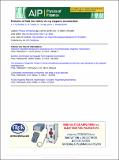Evolution of field line helicity during magnetic reconnection
Abstract
We investigate the evolution of field line helicity for magnetic fields that connect two boundaries without null points, with emphasis on localized finite-B magnetic reconnection. Total ( relative) magnetic helicity is already recognized as an important topological constraint on magnetohydrodynamic processes. Field line helicity offers further advantages because it preserves all topological information and can distinguish between different magnetic fields with the same total helicity. Magnetic reconnection changes field connectivity and field line helicity reflects these changes; the goal of this paper is to characterize that evolution. We start by deriving the evolution equation for field line helicity and examining its terms, also obtaining a simplified form for cases where dynamics are localized within the domain. The main result, which we support using kinematic examples, is that during localized reconnection in a complex magnetic field, the evolution of field line helicity is dominated by a work-like term that is evaluated at the field line endpoints, namely, the scalar product of the generalized field line velocity and the vector potential. Furthermore, the flux integral of this term over certain areas is very small compared to the integral of the unsigned quantity, which indicates that changes of field line helicity happen in a well-organized pairwise manner. It follows that reconnection is very efficient at redistributing helicity in complex magnetic fields despite having little effect on the total helicity.
Citation
Russell , A J B , Yeates , A R , Hornig , G & Wilmot-Smith , A L 2015 , ' Evolution of field line helicity during magnetic reconnection ' , Physics of Plasmas , vol. 22 , no. 3 , 032106 . https://doi.org/10.1063/1.4913489
Publication
Physics of Plasmas
Status
Peer reviewed
ISSN
1070-664XType
Journal article
Description
This work was supported by the Science and Technology Facilities Council (UK) through consortium Grant Nos. ST/K000993/1 and ST/K001043 to the University of Dundee and Durham University.Collections
Items in the St Andrews Research Repository are protected by copyright, with all rights reserved, unless otherwise indicated.

